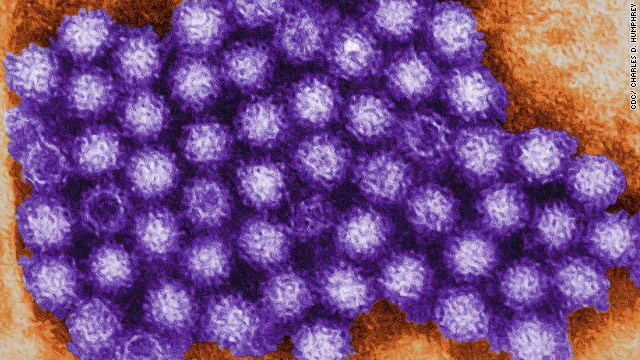(CNN) --
Noroviruses are a group of related viruses that belong to the Caliciviridae family.
The disease occurs when people ingest the infectious virions, which grow in the small intestine before being passed in the feces.
Here, everything you need to know about this disease:
What is norovirus?
Noroviruses are a group of viruses that belong to the Caliciviridae family.
According to data from the Centers for Disease Control and Prevention (CDC), it is possible to get sick from norovirus many times in your life because there are many different types of these viruses, and it is difficult to develop immunity.
Norovirus is the most common cause of acute gastroenteritis — often called a stomach virus — in the United States, according to the CDC.
It causes between 19 and 21 million illnesses each year, most often in crowded settings such as nursing homes, day care centers, and cruise ships.
In the past, norovirus used to be called Norwalk virus or Norwalk-like virus.
advertising
Norovirus cases are at an all-time high in the US, according to CDC data
What are the symptoms?
Norovirus causes inflammation in the stomach and intestines, leading to stomach pain, nausea, and diarrhea.
These symptoms usually last one to three days.
Other symptoms include fever, headache and body aches, according to the CDC.
Frequent diarrhea and vomiting can lead to dehydration, another serious side effect of the virus.
Dehydrated people may not urinate as much, feel dizzy, and have a dry mouth or throat.
How is it different from the flu?
People with these symptoms may think they have had food poisoning or have viral gastroenteritis.
Norovirus can be contracted by eating infected food, which is why it is considered food poisoning.
In fact, norovirus is the most common cause of foodborne illness outbreaks in the United States, according to the CDC.
People usually have symptoms 12 to 48 hours after being exposed to norovirus.
Most people with norovirus illness get better within 1 to 3 days.
But the norovirus is not related to the flu.
The flu is a respiratory illness caused by the influenza virus.
How is it contagious?
Norovirus is highly contagious.
It is a small, hardy virus that can live in the environment for up to four weeks.
The virus can live in the feces of an infected person for two weeks or even longer.
Coming in contact with a surface that has been touched by a patient or with clothing a patient has worn could be enough to contract the disease.
It is also possible to get sick by eating any food that a person with the virus has touched.
Foods commonly involved in outbreaks include shellfish, leafy green vegetables, and fresh fruits.
Norovirus can be spread through food (Shutterstock)
Any food served raw or handled by an infected person after it has been cooked can become contaminated.
Food can also easily become contaminated if it has been out of the fridge for hours, as it often does at a buffet.
People who have norovirus are most contagious when they are sick, but they can transmit the virus even three days after they have recovered from the worst symptoms.
How to treat it?
There is no drug or vaccine to specifically treat norovirus, but most people make a full recovery without treatment (A vaccine is currently in early testing).
Since it is a virus, antibiotics will not kill it;
they only work on bacterial infections.
Someone who has contracted norovirus has only one option, and that is hydration therapy.
When vomiting frequently or suffering from diarrhea, it is necessary to replace the fluids that are lost.
Sports drinks can help with mild dehydration, but water is still the best option.
Oral rehydration fluids are also available without a prescription at most pharmacies and supermarkets.
Getting too dehydrated is dangerous.
In extreme cases, people who don't drink enough fluids can end up hospitalized.
In that case, the patient will receive intravenous fluids.
Hospitals in the United States.
Is norovirus deadly?
Most people will fully recover from norovirus, but it can become serious or even fatal in some patients, such as infants or the elderly.
Norovirus can be contracted at any time, but it is most common in the winter.
Each year, the virus causes approximately 1.8 million doctor visits and 400,000 emergency room visits;
most patients in this situation are children.
Young children and the elderly are more likely to be severely affected by norovirus.
The virus is estimated to cause between 570 and 800 deaths each year, although there are usually more in years when a new strain appears.
This happened in the winters of 2002-03 and 2006-07, according to the CDC.
How can I protect myself?
The best way is not to share food or utensils with sick people.
Thorough hand washing with soap and water is also recommended, especially before preparing or handling food and after using the bathroom.
Alcohol-based hand sanitizer does not kill norovirus and should not be a substitute for traditional soap and water.
If someone around you is sick, be sure to clean any surface they touch with a diluted bleach solution.
Pay special attention to cleaning the bathroom area.
Clean around the toilet, on doorknobs and light switches.
Also make sure you wash the infected person's clothes well.
If someone vomits in bed, change their sheets and towels immediately.
With reporting from CNN's Jen Christensen and Jacque Wilson
norovirus

